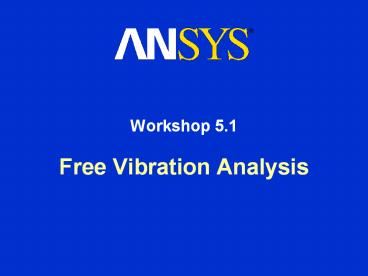Free Vibration Analysis PowerPoint PPT Presentation
Title: Free Vibration Analysis
1
Free Vibration Analysis
- Workshop 5.1
2
Workshop 5.1 - Goals
- Our goal is to investigate the vibration
characteristics of a motor cover manufactured
from 18 gage steel. The cover is to be fastened
to a device operating at 1000 Hz. - Specifically, we want to look at the effect of
reducing the number of fasteners used in the
cover from 5 to 4 for manufacturing efficiency.
3
Workshop 5.1 - Assumptions
- The cover is meant to slip over a cylinder and be
constrained at the bolt hole locations. To
simulate the area contacting the cylinder the
surface has been split (see below). We will use
a frictionless support on this surface to
simulate the contact area. The frictionless
support type applies a constraint that is normal
to the surface, thus axial and tangential
movement is allowed while radial motion is not.
- To simulate the bolted connections a fixed
support type will be used on the edges of the
bolt holes.
Split Surface
4
Workshop 5.1 - Start Page
- From the launcher start Simulation.
- Choose Geometry gt From File . . . and browse
to the file Motor_Cover_5.x_t. - When Workbench Simulation starts, close the
Template menu by clicking the X in the corner
of the window. - Note Before we begin working with this model we
want to bring in the 4 hole version of the part
as well. This will allow us to compare results
in real time.
5
. . . Workshop 5.1 - Start Page
- Before we begin working with this model we want
to bring in the 4 hole version of the part as
well. This will allow us to compare results in
real time. - Highlight the Model branch and RMB gt Duplicate.
- With Model 2 highlighted choose Geometry gt From
File . . . . - Browse to the file Motor_Cover_4.x_t.
6
Workshop 5.1 - Setup
- When the Workbench Simulation GUI opens choose
the U.S. inch pound unit system. - Units gt U.S. Customary (in, lbm, psi, F, s)
7
. . . Workshop 5.1 - Setup
- The 2 models we have chosen are now contained in
separate Model branches (Model and Model 2). To
make the comparison more intuitive, rename the
model branches by right clicking on each Model
branch. Rename as - Model 5 Hole Cover
- Model 2 4 Hole Cover
8
Workshop 5.1 - Preprocessing
- Since the models consist of surface geometry we
will be shell meshing the parts. The first
preprocessing task is to specify the thickness
for the parts in both branches. - Highlight the Part 1 branch for the 5 Hole
Cover. - Notice the Thickness field is currently
displayed in yellow to indicate it is undefined. - Left click in the thickness field and set the
thickness 0.05 in. Repeat for 4 Hole Cover.
3
4
9
Workshop 5.1 - Environment
- Highlight the Environment branch for the 5 Hole
Cover. - Select the split surface, RMB and apply the
frictionless support (make sure you are in face
select mode). - Insert gt Frictionless Support
Split Surface
5
6
10
. . . Workshop 5.1 - Environment
- Switch to edge select mode.
- Hold the control key and select the edges for
each hole. - In the graphics window RMB to apply the fixed
support. - RMB Insert gt Fixed Support.
7
8
11
Workshop 5.1 Solution Setup
- To determine the natural frequencies for the
models we will use the Frequency Finder tool. - Highlight the Solution branch and insert the
frequency finder. - RMB Insert gt Frequency Finder
9
12
. . . Workshop 5.1 Solution Setup
- IMPORTANT steps 6 through 9 completes the setup
for the environment of the 5 hole cover. Before
solving we need to setup the 4 hole cover using
the same boundary conditions. - Highlight the Environment branch for the 4 Hole
Cover model. - Repeat steps 5 to 9 for the second environment.
10
13
Workshop 5.1 - Solution
- With the branches for each model prepared we are
ready to solve. As a final check verify the
status symbols next to the branches. All
branches should have either - Lightening bolt (ready)
- Green check mark (complete)
- Solve both models.
- Highlight the Project branch and solve both
models - RMB Solve
- Note solving from the Project branch causes all
unsolved branches to be solved. Had we wished to
solve only one branch we could have highlighted
only that branch then solved.
14
Workshop 5.1 - Results
- After both solutions are complete expand the
Frequency Finder tools for each branch (click the
to the left of the branch). - Highlighting individual frequency results will
cause a representative plot to be displayed. - The detail for each frequency shows the modes
frequency.
15
. . . Workshop 5.1 - Results
- To get an overall view of the results we can use
the worksheet view. Highlight one of the
frequency finder branches and click on the
Worksheet tab. Repeat for the other FF tool.
16
Workshop 5.1 - Comments
- Remember
- Displacements reported in mode shapes do not
reflect the actual displacements. Actual
displacements will depend on the energy input to
the system.

